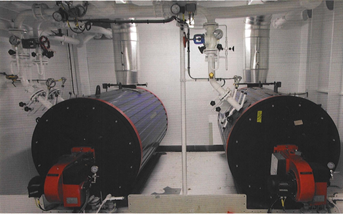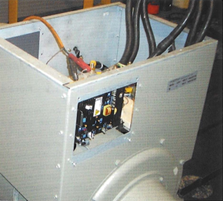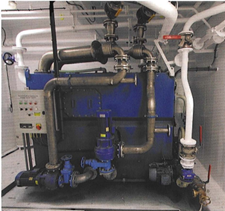Automatic Control Systems
Automatic Control Systems
Automation helps the crew to operate the systems on board easier and safer. It will execute actions which are too complicated for the crew to handle in a given time. Automation allows automatic observation of systems, registration of failures, registration of service time and planned maintenance. Detailed requirements for Automatic Control Systems on board of ships are described in IEC publication 60092-504 Control and instrumentation.
1. Automation
The level of automation depends on a number of factors:
- function of the ship
- cost
- complexity of the installation
- rules and regulations of the classification society and the Flag State (registry).
First of all a cost/availability analysis has to be made before planning automation.
Integration of systems and the introduction of distributed control systems is an ongoing process. It reduces cost of cabling and manning. The only problem is that the rules and regulations of both the classification societies and those of the national authorities cannot keep up with this everchanging process.
Such a control system can consist of programmable logic controllers with remote input and output modules, connected through a two wire bus system and operated/su- pervised from a PC type workstation through an operator-friendly SCADA software package. Redundancy both in hardware and software is a logical requirement for automatic systems. Software must be well-structured and tested as per class standards.
Essential systems required for sailing and comfort of the crew must have sufficient back-up or emergency controls.

Field I/O panel of a distributed automation and control system
1.1. More advanced systems
An operator workstation makes more sophisticated systems possible, including control and display of engine room systems with sophisticated graphics. Trends over a period of time can be captured. Analyses of relationships between figures can be calculated. Running hours and the required automatic logging of all figures can be stored, along with many other statistics.
Some examples of systems that can be part of an automatic control system are:
- Tank gauging system
From the simple, such as providing liquid heights to the more sophisticated, giving tank contents in m3 or even in tons.
- Reefer monitoring system
From failure alarms to complete data logs of the reefer's temperature and CO2 content throughout the voyage, which can prove that cargo is not damaged due to transport.
- Generator control and power management system
From minimum automatic starting of a standby generator in case of generator failure and sequential restarting of all essentials to a complete load-dependent start-stop of the generator plant. In this case, there is automatic power reduction in case of generator failure, until the standby generator is started, has been synchronised, put on-line and has taken the load.
- Propulsion remote control system
From straight forward remote control systems where each handle controls a single engine or propeller to state-of-the-art systems which can make a ship move 25 metres to port, rotate with the stern as rotating point over 90° to port, follow track or a link in location, adjust speed in accordance with available water depth.
In automation there are no technical limits and therefore, a balance between expected results and cost has to be found.
Essential automation systems must be composed of type-approved equipment and are subject to an acceptance test at the manufacturer's under conditions as real as possible.

Two automatic boilers

Governor controlling speed of auxiliary engine

Alternator junction box with AVR open cover

Automatic sewage plant
2 Local control systems
Some equipment has a dedicated local control system which is separated from the central automation system. Most of the time these local control systems exchange some parameters with the central automation system. Examples are:
- Local self-contained small automatic systems controlling lubricating oil temperatures and high and low water temperatures of propulsion and auxiliary diesel engines.
- Local automatic voltage regulators for generators, controlling the voltage.
- Local governors on engines, controlling engine speed.
- Local standby starters for duplicated essential auxiliaries.
- Local automatic boilers
- Local automatic sewage plant.
3 Essential services
Essential services are those services required for sailing and keeping the ship in a habitable condition.
Electric power required for propulsion can be supplied by a single generator set or by more sets in parallel. When supplied by a single generator, failure of this generator set should start a second generator. This generator should automatically be connected to the switchboard followed by automatic restart of all essential auxiliaries.
A sequential start system may be required to limit the step load to the diesel engine.
Essential services include:
- Propulsion engine lubricating oil pumps (if not engine driven)
- Propulsion engine freshwater pumps (if not engine driven)
- Propulsion engines seawater pumps ( if not engine driven)
- Fuel oil booster pumps
- Gearbox lubricating oil pumps
- Controllable pitch propeller hydraulic pumps
- Steering gear hydraulic pumps - Start air compressors
- Engine room fans
On ships sailing on heavy fuel oil, fuel oil circulating pumps, thermal oil circulating pumps and a thermal oil boiler are essential and must automatically restart.
When the electric power required for propulsion is supplied by more generators in parallel, an automatic load shedding system must be fitted. This system reduces the load immediately to the capacity of the remaining generator(s) after failure of one generator.
When large motors with frequency drives are installed the control system can be programmed to reduce the speed of the motors when the generators are close to be overloaded. A complete shutdown of these motors is then not required and when enough power is available again the motors can be set to the original speed.
Sequential restart timing priority:
- After 5 secons, lubricating oil pumps, engines and gearboxes and fuel oil pumps and thermal oil system and pumps
- Steering gear pumps and controllable pitch propeller pumps
- Freshwater pumps and air compressors
- Seawater pumps
- In about 30 seconds, all auxiliaries are back in service and propulsion engines can be restarted
When auxiliaries are engine driven and the engines can be started without lubricating oil pressure, this process is simpler.
4 Failure mode and effect analysis
The Failure Mode and Effect Analysis is an appraisal of the result of a failure of equipment on the operation of a ship (or any other type of equipment). This study is compulsory for units which have to fulfill the requirements of the MODU Code.
The MODU Code is one of the IMO Codes, especially drawn up for offshore equipment. MODU stands for Mobile Offshore Drilling Unit.
Originally for drilling equipment only, but later made a requirement for offshore equipment in general. FMEA is not limited to the automation of electrical systems but covers all systems required for propulsion of a ship and all components.
The following example of an FMEA covers the layout, the auxiliary systems and the electrical installation of a large pipe lay vessel with the following main characteristics:
- Thrusters forward, two retractable azimuth thrusters each 2400kW, one tunnel thruster 2200kW
- Three azimuth thrusters each 2900kW aft
- Class notation Lloyd's Register + 100A1, +LMC, UMS, DP(AA) equal to class 2.
The class notation DP(AA) or class 2, requires that a single failure does not result in loss of position of the vessel. Flooding or fire of a space is not considered in this notation.
The ship is designed for dual fuel but marine gas oil is used during DP operation with heavy fuel only for long passages or between jobs.
An FMEA addresses the items:
2. Compressed air systems
3. Cooling water systems
4. Fuel oil systems
5. Freshwater system
6. Seawater system
7. Thruster control system
8. Electric main distribution system
 +7 (812) 4-673-673
+7 (812) 4-673-673